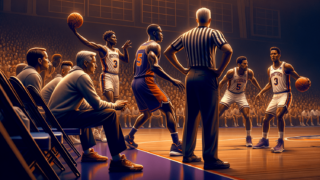
Basket Interference Rule in Basketball
Written by: Basketball Universe
Last updated:

Get ready to dive into the fascinating world of the Basketball Interference Rule, an essential and intriguing aspect of the game! Despite its complex nature, this mighty rule helps maintain accuracy and fairness, making sure that the breathtaking slams and sky-high leaps are nothing short of spectacular. Whether you’re a casual fan or a hoops aficionado, join us as we unveil the depths of this unique rule and satisfy your curiosity with all there is to know about basketball interference. So, bring out your inner basketball savant and let’s jump right in!
Basket Interference Rule in Basketball
The Basket Interference Rule in basketball is a regulation that prohibits players from touching the ball when it is on or directly above the rim, within the cylinder extending from the rim, or on its downward flight towards the basket with a chance to score. Should a player touch the ball during these instances, basket interference is called, leading to either the offensive team losing possession or the defensive team conceding points, depending on the scenario.
From Fundamentals to Finesse: Defining Basket Interference
At its core, the basket interference rule in basketball is designed to prevent players from unfairly affecting a potential scoring opportunity. This can happen in several scenarios, such as when the ball is in or on the rim, when it’s directly above the cylinder, and when it’s on its downward trajectory towards the hoop with a chance to score.
Offensive Interference: A Shot Gone Wrong
Offensive basket interference happens when an offensive player touches the ball during one of these scenarios. When this occurs, the basket does not count, and possession of the ball goes to the opposing team. The rationale behind this rule is simple yet essential: it ensures that players on the offensive side cannot make their own shots easier by interfering with the ball or the hoop.
Defensive Interference: A Deterrent for Overzealous Defense
Defensive basket interference, on the other hand, occurs when a defensive player touches the ball during one of the aforementioned situations. In this case, the offensive team is awarded the points for the shot attempt, regardless of whether the ball would have gone through the hoop or not. This rule helps keep defensive players honest, preventing them from disturbing the natural course of the game by swatting the ball away from the rim or altering its course.
Understanding Basketball Rules: The Birth of Basket Interference
The basket interference rule has deep roots in the history of basketball, dating back to the early 20th century. As the game evolved and players’ physicality and skill levels improved, the need for a rule to protect fair play became evident. Players leaping towards the basket and altering the trajectory of the ball could lead to an unfair advantage, which is why the inception of this rule came to be. The rule not only shows the game’s dedication to sportsmanship but also highlights the importance of maintaining a level playing field.
A Deeper Dive: Nuances of the Rule
Now that we’ve established a foundational understanding of the basket interference rule, it’s essential to unpack the subtleties and variations that further refine the rule and exemplify its importance in the game.
Goal Tending: Swatting the Ball too Late
Goal tending is a specific type of defensive interference rule where a defensive player interferes with the ball when it’s on its downward flight towards the basket with a chance to score. If a player deflects or blocks a shot attempt after it has reached its peak and started to descend, it’s considered goal tending, and the offensive team is awarded the points for the shot attempt. Understanding goal tending adds another crucial piece to the basket interference puzzle and emphasizes the impact of the rule on the overall game.
Technicalities and Exceptions: The Rim-Pull Rule
Another interesting aspect of the basket interference rule is the prohibition of players from touching the rim or pulling the net during a shot attempt to alter the movement of the ball. This act is deemed interference and is called according to the offensive or defensive nature of the interference. However, this rule provides an exception for players who touch the rim or net incidentally and without affecting the ball’s trajectory. It’s fascinating to see how the rule considers potential fringe cases, showing the comprehensive nature of basketball regulations.
Different Leagues, Different Perspectives: Basket Interference Around the World
The basket interference rule is a global phenomenon, serving as a constant in the game of basketball despite minor variations across different leagues and governing bodies.
FIBA: The International Stage
The International Basketball Federation (FIBA) follows the basket interference rule with some subtle differences from the NBA. In FIBA competitions, defensive goal tending is called when a player touches the ball after it has touched the backboard and started its downward trajectory or when the ball is entirely above the rim level. Such distinctions keep the spirit of the rule intact while accounting for the unique character of international basketball.
NCAA: The Collegiate Arena
In the National Collegiate Athletic Association (NCAA), the basket interference rule is enforced similarly to the NBA. However, the NCAA also includes a “restricted area” or charge circle in the lane – a semi-circle with a 3-foot radius from the center of the rim – where defenders are not allowed to take an offensive charge. This addition makes NCAA basketball rules distinct and highlights the importance of location when it comes to interference.
Supplementing Knowledge: How Basket Interference Relates to Other Rules
As a basketball enthusiast, it’s crucial to understand how the basket interference rule interacts with other basketball regulations, enhancing the overall harmony of the game and ensuring the highest level of fair competition.
The Shot Clock and Interference
An interesting intersection between the basket interference rule and the shot clock rule occurs when there’s a shot taken right as the shot clock is about to expire. If the ball leaves the shooter’s hand just as the buzzer sounds and interference is called, the referees must determine if the interference happened before or after the buzzer. If it happened before, the play is ruled a basket interference and points are awarded accordingly. If it happened after, the points do not count as the shot would not have beaten the buzzer.
The Importance of Positioning
The basket interference rule also ties in with player positioning on the court. A player needs to have solid positioning and anticipation to avoid committing basket interference, whether on offense or defense. This emphasis on proper body orientation and decision-making demonstrates the link between the rule and the strategic aspects of the game.
Developing Your Hoops IQ
Now that you’re well-versed in the basket interference rule, why not take your newly acquired knowledge and put it into practice? There are several ways you can do this to become a better and more informed basketball fan, player, or coach. Let’s explore some options:
Put it to the Test: Watching Basketball with a Critical Eye
As you watch your favorite basketball games or highlights, pay close attention to instances of basket interference or goal tending. Notice how referees handle these situations and how players adapt their positioning accordingly. This exercise will not only help reinforce your understanding of the rule but also enable you to appreciate the layers of strategy, skill, and athleticism involved in basketball.
On-Court Application: Playing the Right Way
If you’re a basketball player, use your newfound knowledge of the basket interference rule in your gameplay. Focus on developing the necessary anticipation and positioning skills to avoid committing interference while still maximizing your on-court impact. By doing so, you’ll become a stronger, more intelligent player who can better navigate the labyrinth of basketball rules.
Coaching Considerations: Imparting Wisdom
Coaches are pivotal in ensuring that players understand and respect the rules of basketball, including the basket interference rule. As a coach, emphasize the importance of the rule in practice and games, and teach players to utilize their positioning and decision-making prowess to their advantage. With your guidance, your team will be better prepared to tackle anything the game may throw their way.
By knowing the ins and outs of the basket interference rule, you’re taking an essential step towards mastering the game of basketball. Let this newfound knowledge fuel your love and appreciation for the sport, its rules, and its ever-evolving complexities.
Tripping Over the Technicals: Rule Enforcement & Penalties
Delving deeper into the world of basket interference, it’s vital to understand how this rule is enforced during a game and the penalties associated with it. Differentiating between accidental interference and purposeful interference, referees play a critical role in enforcing the rule and maintaining fair play.
Referees: Enforcers on the Court
Referees are entrusted with the responsibility of determining whether basket interference has occurred during the game. They must decide if a player touched the ball while it was on or above the rim, within the cylinder, or during its downward flight towards the hoop. This can be a challenging task, especially in fast-paced games, making the role of referees crucial for upholding the integrity of the game.
Offensive Interference Penalty
When referees call offensive basket interference, the attacking team loses possession of the ball, and any points from the disallowed shot are nullified. The opposing team receives the ball, allowing them to reset and play defense, thus limiting the potential advantage gained from interference.
Defensive Interference Penalty
In the case of defensive basket interference, the officials award the points for the shot attempt to the attacking team. If the shot was from beyond the three-point arc, the team receives three points; otherwise, they are awarded two points. The defensive team is penalized for their interference, and the game continues without interruption.
Seeing Through the Replay: Reviewing Basket Interference
In an age where technology is integrated into various aspects of our lives, it is no surprise that video replay is now being used to review controversial calls in basketball games, including basket interference. The implementation of instant replay reviews has been a hot topic of debate, and its impact on the game has been significant.
Instant Replay Rule
The introduction of instant replay technology in basketball games has changed how referees handle situations like basket interference. While it is essential to make the correct calls during a game, human error can sometimes factor in, leading to incorrect calls. The instant replay rule has been implemented to aid referees in making decisions, especially in crucial moments of the game.
Controversial Calls & Impact on the Game
When highly contested or controversial basket interference situations occur, officials may use instant replay to review the call. They must determine whether the original call was accurate and make the necessary changes accordingly. This intervention has led to more accurate calls and a better understanding of the ever-evolving dimensions of the game.
Putting it All Together: The Role of Basket Interference in Basketball Culture
Understanding how the basket interference rule affects basketball culture is paramount to truly gauging its significance. From player development to coaching strategies, the rule’s impact stretches far and wide, shaping how the game is played and experienced.
Player Development: Refined Skills, Winning Strategies
As players grow and develop their basketball skills, the basket interference rule plays an essential part in their progression. Coaches and trainers dedicate time to help players understand the rule, how it applies in different in-game situations, and how to navigate around it. This awareness helps players refine their skills, improve their strategic decision-making, and elevate the quality of play on the court.
Fan Engagement: Enthusiasm & Debate
Fans form the backbone of any sport, and basketball wouldn’t be the same without them. The basket interference rule often leads to heated discussions and debates between fans about whether a call was right or wrong. The intricacies and emotion-filled moments brought forth by this rule significantly contribute to basketball’s allure and the passion and loyalty of its fans.
Coaching Strategies: Adapting to Rule Changes
As the game evolves and new rules are introduced, coaches adapt their strategies to maximize their team’s performance on the court. With the basket interference rule, coaches must find ways to incorporate positioning and anticipation drills into practice routines while stressing the importance of avoiding interference. This vigilance helps improve player performance, which in turn leads to more competitive and engaging games.
The basket interference rule is undeniably an essential component of basketball, affecting not just the players but also the game’s global culture. By understanding the nuances and intricacies of the rule, you’ll appreciate the game on a deeper level and enjoy every moment of the sport you love.
Frequently Asked Questions: Basket Interference Rule in Basketball
We understand that you may have additional questions related to the basket interference rule in basketball. In this FAQ section, we’ve compiled a list of ten common questions that are pertinent to the topic. Let’s address these questions to give you a better understanding of this significant rule.
1. When is a shot considered to be in the cylinder?
A shot is considered to be within the cylinder when any part of the ball is directly above the rim of the hoop, creating an imaginary cylinder that extends from the rim to the ceiling. During this time, touching the ball by either an offensive or defensive player results in basket interference.
2. Is basket interference only for shots or can it apply to rebounds as well?
Basket interference mostly applies to shot attempts, but it can also affect rebounds. In situations where the ball is within the cylinder after a missed shot, players cannot touch the ball or the rim until the ball leaves the cylinder, or they risk being called for basket interference.
3. Are there any differences in the rule between high school, college, and NBA levels?
While the essence of the basket interference rule remains the same across all basketball levels, there are minor variations between high school, college, and NBA basketball, such as the introduction of the restricted area in the NCAA. However, the primary focus of the rule is constant: to prevent players from touching the ball when it’s on, above the rim, or within the cylinder.
4. Can a player be called for goal tending if they block a shot before it starts to descend?
Goal tending can only be called when a player interferes with a shot that has reached its peak and has started its downward trajectory towards the basket. If a player blocks the shot before it begins to descend, it is not considered goal tending, and the block is allowed to stand.
5. How are officials trained to recognize and call basket interference?
Officials receive extensive training to recognize and call basket interference, as well as other basketball rules. They undergo education programs, attend seminars, and participate in on-court training sessions to sharpen their skills and ensure that they can accurately enforce the rules during games.
6. Is touching the rim/net during a dunk considered basket interference?
Touching the rim or net while dunking the ball is generally not considered basket interference, as the act of dunking inherently involves touching the rim. However, if a player were to hang on the rim or pull on the net in such a way that it alters the trajectory of the ball, basket interference could be called.
7. Can a player touch the ball after it makes contact with the backboard?
A player can touch the ball after it contacts the backboard as long as it is not within the cylinder and the ball has not begun its downward trajectory with a chance to score. Touching the ball in either of these instances would result in basket interference or goal tending.
8. Can the offensive team be awarded more points for a defensive interference on a three-point shot attempt?
Yes, if a defensive basket interference is called on a three-point shot attempt, the offensive team is awarded three points, regardless of whether the shot would have gone in or not.
9. Does basket interference apply to every type of shot made from anywhere on the court?
Basket interference applies to all types of shots made from any location on the court. The rule’s purpose is to prevent players from touching the ball when it’s on, above the rim, or within the cylinder, thus affecting the outcome of the shot attempt.
10. How do referees determine which player committed the basket interference?
Referees determine who committed the interference based on their positioning, observation, and judgment. They must monitor the basketball court and maintain close proximity to the action, actively watching each player’s movement and contact with the ball, the rim, or the net. Following these observations, they make the call based on their well-founded judgment.
Featured Posts
- No pillar pages found.





